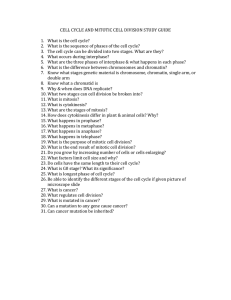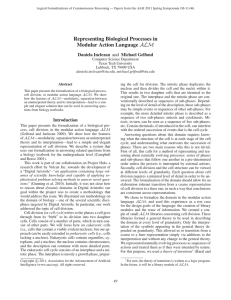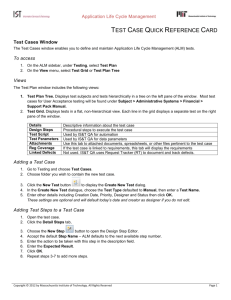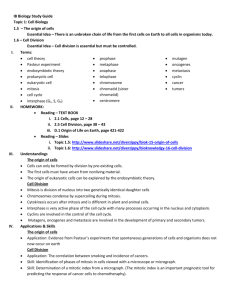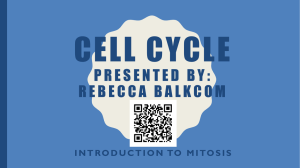Representing Biological Processes in Modular Action Language ALM
advertisement
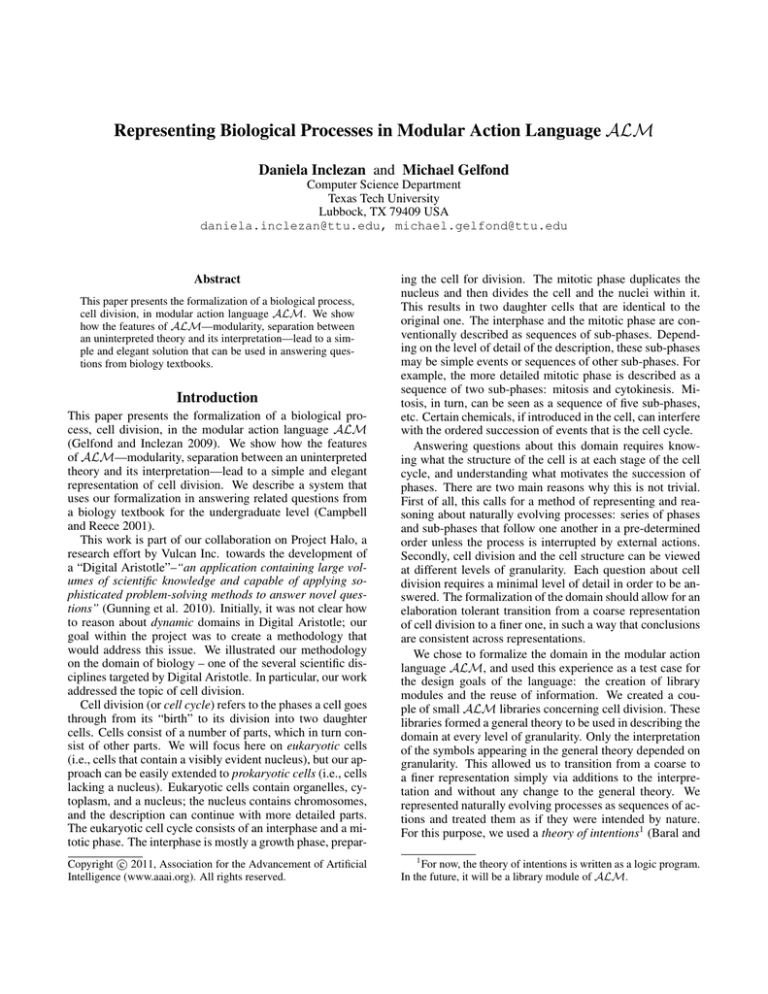
Representing Biological Processes in Modular Action Language ALM
Daniela Inclezan and Michael Gelfond
Computer Science Department
Texas Tech University
Lubbock, TX 79409 USA
daniela.inclezan@ttu.edu, michael.gelfond@ttu.edu
Abstract
This paper presents the formalization of a biological process,
cell division, in modular action language ALM. We show
how the features of ALM—modularity, separation between
an uninterpreted theory and its interpretation—lead to a simple and elegant solution that can be used in answering questions from biology textbooks.
Introduction
This paper presents the formalization of a biological process, cell division, in the modular action language ALM
(Gelfond and Inclezan 2009). We show how the features
of ALM—modularity, separation between an uninterpreted
theory and its interpretation—lead to a simple and elegant
representation of cell division. We describe a system that
uses our formalization in answering related questions from
a biology textbook for the undergraduate level (Campbell
and Reece 2001).
This work is part of our collaboration on Project Halo, a
research effort by Vulcan Inc. towards the development of
a “Digital Aristotle”–“an application containing large volumes of scientific knowledge and capable of applying sophisticated problem-solving methods to answer novel questions” (Gunning et al. 2010). Initially, it was not clear how
to reason about dynamic domains in Digital Aristotle; our
goal within the project was to create a methodology that
would address this issue. We illustrated our methodology
on the domain of biology – one of the several scientific disciplines targeted by Digital Aristotle. In particular, our work
addressed the topic of cell division.
Cell division (or cell cycle) refers to the phases a cell goes
through from its “birth” to its division into two daughter
cells. Cells consist of a number of parts, which in turn consist of other parts. We will focus here on eukaryotic cells
(i.e., cells that contain a visibly evident nucleus), but our approach can be easily extended to prokaryotic cells (i.e., cells
lacking a nucleus). Eukaryotic cells contain organelles, cytoplasm, and a nucleus; the nucleus contains chromosomes,
and the description can continue with more detailed parts.
The eukaryotic cell cycle consists of an interphase and a mitotic phase. The interphase is mostly a growth phase, preparc 2011, Association for the Advancement of Artificial
Copyright Intelligence (www.aaai.org). All rights reserved.
ing the cell for division. The mitotic phase duplicates the
nucleus and then divides the cell and the nuclei within it.
This results in two daughter cells that are identical to the
original one. The interphase and the mitotic phase are conventionally described as sequences of sub-phases. Depending on the level of detail of the description, these sub-phases
may be simple events or sequences of other sub-phases. For
example, the more detailed mitotic phase is described as a
sequence of two sub-phases: mitosis and cytokinesis. Mitosis, in turn, can be seen as a sequence of five sub-phases,
etc. Certain chemicals, if introduced in the cell, can interfere
with the ordered succession of events that is the cell cycle.
Answering questions about this domain requires knowing what the structure of the cell is at each stage of the cell
cycle, and understanding what motivates the succession of
phases. There are two main reasons why this is not trivial.
First of all, this calls for a method of representing and reasoning about naturally evolving processes: series of phases
and sub-phases that follow one another in a pre-determined
order unless the process is interrupted by external actions.
Secondly, cell division and the cell structure can be viewed
at different levels of granularity. Each question about cell
division requires a minimal level of detail in order to be answered. The formalization of the domain should allow for an
elaboration tolerant transition from a coarse representation
of cell division to a finer one, in such a way that conclusions
are consistent across representations.
We chose to formalize the domain in the modular action
language ALM, and used this experience as a test case for
the design goals of the language: the creation of library
modules and the reuse of information. We created a couple of small ALM libraries concerning cell division. These
libraries formed a general theory to be used in describing the
domain at every level of granularity. Only the interpretation
of the symbols appearing in the general theory depended on
granularity. This allowed us to transition from a coarse to
a finer representation simply via additions to the interpretation and without any change to the general theory. We
represented naturally evolving processes as sequences of actions and treated them as if they were intended by nature.
For this purpose, we used a theory of intentions1 (Baral and
1
For now, the theory of intentions is written as a logic program.
In the future, it will be a library module of ALM.
Gelfond 2005; Gelfond 2006) containing the following main
tenets: “Normally intended actions are executed the moment
such execution becomes possible” (non-procrastination) and
“Unfulfilled intentions persist” (persistence).
We evaluated our work by addressing several textbook
questions about cell division. The information given in the
question was extracted by hand; relations present in the text
of the question but absent from our knowledge base were
also defined by hand by way of logic programming rules.
The minimal level of detail required to answer each question was detected manually; automatic detection is part of
future work. The ALM system descriptions for the various levels of granularity were translated into logic programs.
This allowed us to reduce the problem of question answering to computing answer sets (Gelfond and Lifschitz 1991)
of a program consisting of: the encoding of the question,
the translation of the corresponding system description, and
the theory of intentions. In doing so, we applied a known
approach for answering non-trivial questions about dynamic
domains using logic programs under the answer set semantics (Baral, Gelfond, and Scherl 2004; Baral et al. 2005;
Balduccini, Baral, and Lierler 2008). Based on our evaluation, we concluded that ALM’s features are useful in representing and reasoning about domains like cell division in
an elegant manner.
This paper is structured as follows: we begin with a short
introduction to ALM by way of examples. Next, we present
our formalization of the domain in ALM. We continue with
the representation of several questions from the biology textbook. Finally, we describe the architecture of our system and
end with conclusions.
Modular Action Language ALM
ALM is an extension of action language AL (Turner 1997;
Baral and Gelfond 2000) by means for expressing hierarchies of abstractions. In particular, ALM has a modular
structure and makes a clear distinction between an uninterpreted theory and its interpretation. These features allowed
us to address the difficulties of formalizing cell division, as
will be shown in the next section. A system description of
ALM is a set of modules forming the uninterpreted theory
(the declarations part), followed by an interpretation of
the symbols (the structure):
system description name
declarations of name
module module name {. . .}
structure of name {. . .}
Syntactically, a module can be viewed as a collection of
declarations of sort, fluent and action classes of the system.
We show the syntax of a module by means of an example:
module move between areas
sort declarations
things, areas : sort
movers : things
fluent declarations
loc in(things, areas) : inertial fluent
axioms
¬loc in(T, A2 ) if disjoint(A1 , A2 ), loc in(T, A1 ).
end of loc in
action declarations
move : action
attributes
actor : movers
origin, dest : areas
axioms
move causes loc in(O, A) if actor = O,
dest = A.
impossible move if actor = O,
origin = A,
¬loc in(O, A).
end of move
This says that things, areas, and movers are sorts, where
movers is a sub-sort of things; loc in is an inertial fluent
with parameters of the sorts things and areas; and move
is an action class. The fluent loc in is defined by the static
causal law included in its axioms part. Actions of the
type move have three attributes: actor, with values from
the sort movers, and origin and dest, with values from the
sort areas. The first move axiom says that the occurrence
of any action that is an instance of move and has actor O
and destination A causes O to be located in A. The second
axiom says that no instance of action class move can occur
in a state in which its actor is not located at the origin.
Modules can be combined into libraries and imported
from there using import statements. As modules are organized as tree-like hierarchies, actions and fluents can be defined in terms of other actions and fluents. In the example
above, the inertial fluent loc in was defined in terms of the
fluent disjoint, assumed to be declared in a different module. The next example shows how an action class, carry,
can be declared in terms of an already declared action class:
carry : move
attributes
carried thing : carriables
axioms
impossible carry if actor = O,
carried thing = T,
¬holding(O, T ).
end of carry
This says that carry is a special case of the action class
move, meaning that, in addition to its own attributes and
axioms, carry inherits the attributes and axioms of move.
The next part after the declarations of a system description is its interpretation. The following example illustrates
the syntax of an interpretation; we assume that the declaration part of the system description basic travel contains the
module move between areas:
structure of basic travel
sorts
bob, john ∈ movers
london, paris, rome ∈ areas
actions
instance move(O, A1 , A2 ) : move
actor := O
origin := A1
dest := A2
statics
disjoint(london, paris).
disjoint(paris, rome).
disjoint(rome, london).
This structure defines objects of sorts movers and areas
from our domain, instances of action move and the value of
static fluents.
Semantically, a collection of modules can be viewed as a
mapping of possible interpretations of the symbols of the
domain into the transition diagram describing a dynamic
system. A system description D of ALM is mapped into
ground statements of the non-modular action language AL,
which uniquely define the transition diagram of D. For example, the action instance move(bob, london, paris) and
the ALM causal law
move causes loc in(O, A) if actor = O, dest = A.
are turned into the AL causal law
move(bob, london, paris) causes loc in(bob, paris).
Statements of AL can then be translated into Answer Set
Programming (ASP) rules.
System descriptions of ALM are normally used in conjunction with the description of the system’s history, a collection of facts of the form: happened(a, i) (action a happened at time step i); observed(f, true/f alse, i) (fluent f
was observed to be true/f alse at i); and intend(v, i) (the
execution of the action or sequence of actions v was intended
at i). Together, the system description and the history define
the collection of possible trajectories of the system up to the
current step. These trajectories can be extracted from the
answer sets of a logic program consisting of the translation
of the ALM system description, the system’s history, and
axioms for happened, observed, and intend.
Formalizing Cell Division in ALM
We now present our formalization of cell division. We start
by modeling the eukaryotic cell. As seen in the introduction,
the eukaryotic cell consists of various parts, which in turn
consist of other parts. Together, they form a “part of ” hierarchy, say H. To model this hierarchy, we introduce a sort
called classes of parts (abbreviated here as c o p) and the
relations: f ather(C1 , C2 ), where C1 is the father class of
class C2 in H, and root(C), where C is the root of H. We
will be interested in the number of different parts present
in the environment during different stages of the cell cycle.
Therefore, the states of our domain will be described by an
inertial fluent, num(C1 , C2 , N ), which holds if the number
of parts from class C1 in one part from the class C2 is N .
For instance, num(nucleus, cell, 2) will indicate that at the
current stage of the cell cycle, every cell in the environment
has two nuclei.
Next, we present the actions of our domain. To describe
the cell cycle we will need two action classes: duplicate
and split. Duplicate, which has an attribute class of sort
classes of parts, doubles the number of every part from
this class present in the environment. Split, which also
has an attribute class, duplicates elements of this class and
cuts in half the number of parts from the daughter classes
of class. For example, if the environment consists of one
cell with two nuclei, the action instance split(cell) will increase the number of cells to two, each containing only one
nucleus. In addition to these two actions we will have an
exogenous action, prevent, which will nullify the effects
of duplication and splitting for class C. We will make use
of this exogenous action in representing external events that
interfere with the normal succession of sub-phases of cell
division. The description of the domain is given in a module
called basic cell cycle, which will eventually become part
of a more general cell cycle library module.
module basic cell cycle
sort declarations
classes of parts : sort %c o p
numbers : sort
even numbers : numbers
fluent declarations
f ather(c o p, c o p) : static fluent
axioms
¬f ather(C1 , C)
if
¬f ather(C1 , C)
if
f ather(C2 , C),
C1 6= C2 .
root(C).
end of f ather
root(c o p) : static fluent
axioms
¬root(C1 )
end of root
if
root(C2 ), C1 6= C2 .
num(c o p, c o p, numbers) : inertial fluent
axioms
¬num(C1 , C2 , N2 )
if
num(C3 , C1 , N )
if
num(C1 , C2 , N1 ),
N1 6= N2 .
f ather(C1 , C2 ),
num(C2 , C1 , N1 ),
num(C3 , C2 , N2 ),
C3 6= C2 ,
N = N1 ∗ N2 .
end of num
prevented dupl(classes of parts) :
inertial fluent
action declarations
duplicate : action
attributes
class : classes of parts
axioms
duplicate
causes
if
num(C1 , C2 , N2 )
class = C1 ,
f ather(C2 , C1 ),
num(C1 , C2 , N1 ),
N2 = 2 ∗ N1 .
impossible duplicate if class = C,
prevented dupl(C).
end of duplicate
split : duplicate
axioms
split
causes
if
num(C1 , C2 , N2 )
class = C2 ,
f ather(C2 , C1 ),
num(C1 , C2 , N1 ),
even numbers(N1 ),
N1 6= 0, N1 = N2 ∗ 2.
end of split
prevent duplication : action
attributes
class : classes of parts
axioms
prevent duplication causes prevented dupl(C)
if class = C.
end of prevent duplication
As mentioned previously, the cell cycle is conventionally
described as a sequence of two consecutive phases, which
in turn consist of other sub-phases. The following module
represents knowledge about sequences of actions.
module sequence
sort declarations
elements, sequences, numbers : sort
fluent declarations
component(elements, numbers, sequences) :
static fluent
length(numbers, sequences) : static fluent
axioms
¬length(N1 , S) if length(N2 , S),
N1 6= N2 .
end of length
Various system descriptions of ALM specifying this
process at different levels of granularity will contain the
basic cell cycle and sequence modules and will differ from
each other only by their structure. This shows that ALM’s
feature of separating the interpreted theory from its interpretation is useful in representing domains at different levels of
abstraction.
We first consider a model in which cell cycle is viewed
as a sequence consisting of the interphase and the mitotic
phase. Interphase is considered to be an elementary action,
whereas the mitotic phase is a sequence of two elementary
actions: mitosis and cytokinesis. We also limit our domain
to cells contained in an experimental environment that is
usually called sample. This refinement of the cell cycle includes the modules basic cell cycle and sequence, and the
structure:
structure of cell cycle(1)
sorts
sample, cell, nucleus ∈ classes of parts
cell cycle, mitotic phase ∈ sequences
interphase, mitotic phase, mitosis, cytokinesis
∈ elements
actions
instance interphase : action
instance mitosis : duplicate
class := nucleus
instance cytokinesis : split
class := cell
statics
f ather(sample, cell).
f ather(cell, nucleus).
root(sample).
component(interphase, 1, cell cycle).
component(mitotic phase, 2, cell cycle).
length(2, cell cycle).
component(mitosis, 1, mitotic phase).
component(cytokinesis, 2, mitotic phase).
length(2, mitotic phase).
We can use this initial model to determine the number
of cells and nuclei in the sample at the end of the cell cycle,
assuming that our initial sample consists of one cell with one
nucleus. The solution can be obtained from the answer set
of a program, Π1 , consisting of the ASP translation of the
cell cycle(1) system description, the theory of intentions,
and the domain history. The history, H1 , is written as:
observed(num(cell, sample, 1), true, 0).
observed(num(nucleus, cell, 1), true, 0).
intend(cell cycle, 0).
The last statement of H1 captures our intuition that the purpose of a cell is to divide, expressed as an intention. The
answer set of Π1 will contain the last step 3 and the facts:
holds(num(cell, sample, 2), 3)
holds(num(nucleus, sample, 2), 3)
holds(num(nucleus, cell, 1), 3)
Hence, at the end of the cycle, the sample contains two cells
with one nucleus each.
Representing Textbook Questions
We now present our approach in answering several end-ofthe-chapter review questions about cell division; the questions are taken from a biology textbook (Campbell and
Reece 2001). We start with question 12.9: “In some organisms mitosis occurs without cytokinesis occurring. This
”. To encode the information given in the
will result in
text of this question, we simply expand the history H1 by
¬happened(cytokinesis, I)
for every step I. The expression “will result in” (which appears in the text) is encoded via the predicate result defined
by the rule:
result(F ) ← f luent(inertial, F ),
holds(F, I),
last step(I).
The corresponding answer set will now contain:
result(num(cell, sample, 1))
result(num(nucleus, sample, 2))
result(num(nucleus, cell, 2))
which indicates that the result is one cell with two nuclei.
Next, we consider question 12.15: “A researcher treats
cells with a chemical that prevents DNA synthesis. This
treatment traps the cells in which part of the cell cycle?”
To answer this question the system will need to know more
about the structure of the cell and that of the interphase and
mitosis. The second refinement of the cell cycle provides
this additional knowledge. The following cell components
will be added: the chromosomes inside the nucleus, the chromatids that are part of the chromosomes, and the DNA inside the chromatids. The interphase is a sequence [g1 , s, g2 ]
where g1 and g2 are elementary actions and s is a sequence
of two elementary actions: DNA synthesis, and the creation of sister chromatids. Mitosis is a sequence of five actions: prophase, prometaphase, metaphase, anaphase, and
telophase. The treatment of the cells with the chemical is
represented by an exogenous action that prevents the duplication of the DNA.
structure of cell cycle(2)
sorts
sample, cell, nucleus, chromosome, chromatid,
dna ∈ classes of parts
cell cycle, mitotic phase, interphase, s, mitosis
∈ sequences
interphase, mitotic phase, mitosis, cytokinesis,
g1, s, g2, dna synthesis, sister chromatids,
prophase, prometaphase, metaphase, anaphase,
telophase ∈ elements
actions
instance g1 : action
instance dna synthesis : duplicate
class := dna
instance sister chromatids : split
class := chromatid
instance g2 : action
instance prophase : action
instance prometaphase : action
instance metaphase : action
instance anaphase : split
class := chromosome
instance telophase : split
class := nucleus
instance cytokinesis : split
class := cell
instance treatment : prevent duplication
class := dna
statics
f ather(sample, cell).
f ather(cell, nucleus).
f ather(nucleus, chromosome).
f ather(chromosome, chromatid).
f ather(chromatid, dna).
root(sample).
component(interphase, 1, cell cycle).
component(mitotic phase, 2, cell cycle).
length(2, cell cycle).
component(g1, 1, interphase).
component(s, 2, interphase).
component(g2, 3, interphase).
length(3, interphase).
component(dna synthesis, 1, s).
component(sister chromatids, 2, s).
length(2, s).
component(mitosis, 1, mitotic phase).
component(cytokinesis, 2, mitotic phase).
length(2, mitotic phase).
component(prophase, 1, mitosis).
component(prometaphase, 2, mitosis).
component(metaphase, 3, mitosis).
component(anaphase, 4, mitosis).
component(telophase, 5, mitosis).
length(5, mitosis).
We can capture the scenario in question 12.15 via the following history denoted by H2 :
observed(num(cell, sample, 1), true, 0).
observed(num(nucleus, cell, 1), true, 0).
observed(num(chromosome, nucleus, 1), true, 0).2
observed(num(chromatid, chromosome, 1), true, 0).
observed(num(dna, chromatid, 1), true, 0).
intend(cell cycle, 0).
happened(treatment, 0).
The occurrence of action “treat cells” from the story is
represented via the observation that the exogenous action
treatment happened at 0, included in H2 . To answer our
question, we define a relation trapped in: the cell is trapped
in phase V if V precedes an intended phase that never started
trapped in(V ) ← component(V, K, S),
component(V1 , K1 , S),
intended(V1 ),
not started(V1 ),
K1 = K + 1.
We add the rule above to the ASP encoding. The answer
set of the resulting program will contain trapped in(g1),
where g1 is the answer to question 12.15.
Now, let us address question 12.4: “A particular cell has
half as much DNA as some of the other cells in a mitotically
active tissue. The cell in question is most likely in:
a. G1
c. prophase
e. anaphase”
b. G2
d. metaphase.
This question can be rephrased as: “In which of the following sub-phases does a mitotically active cell have half as
much DNA as in other sub-phases.” We use the second refinement of cell division, cell cycle(2). The domain history,
H3 , obtained from the text of the question is identical to H2 ,
except for the statement happened(treatment, 0).
We add to our encoding the following axioms defining the
relation “half as much DNA” in the question:
half (A) ← action(A),
occurs(A, I),
holds(num(dna, cell, N ), I),
holds(num(dna, cell, N1 ), I1 ),
N1 = N ∗ 2.
half (S) ← sequences(S),
constant num dna cell in(N, S),
holds(num(dna, cell, N1 ), I1 ),
N1 = N ∗ 2.
The relation half (V ) holds if V is a phase during which the
amount of DNA per cell has a constant value and there is
some state of the cell cycle that has double that amount. We
encode the possible answers as:
answer(a) ← half (g1).
answer(b) ← half (g2).
answer(c) ← half (prophase).
answer(d) ← half (metaphase).
answer(e) ← half (anaphase).
2
The number of chromosomes per nucleus depends on the
species. When it is not given, we can assume it is 1.
The answer set of the program that is obtained will contain
half (g1) and answer(a), as expected.
Finally, we consider question 12.12: “Starting with a fertilized egg (zygote), a series of five cell divisions will produce an early embryo with how many cells?” In order to
answer this question, our refinement of cell division only
needs to specify two elements of the sort classes of part:
the sample and the cell. The refinement does not need to
mention the sub-phases of the cell cycle; rather, the cell cycle can be viewed as a simple action of the type duplicate.
Additionally, the refinement will include a sequence called
f ive divisions, consisting of five cell cycle actions:
structure of cell cycle(3)
sorts
sample, cell ∈ classes of parts
f ive divisions ∈ sequences
cell cycle ∈ elements
actions
instance cell cycle : duplicate
class := cell
statics
f ather(sample, cell).
root(sample).
component(cell cycle, 1, f ive divisions).
component(cell cycle, 2, f ive divisions).
component(cell cycle, 3, f ive divisions).
component(cell cycle, 4, f ive divisions).
component(cell cycle, 5, f ive divisions).
length(5, f ive divisions).
Our history, H4 , will be:
observed(num(cell, sample, 1), true, 0).
intend(f ive divisions, 0).
The answer set will contain ends(f ive divisions, 5)3 and
holds(num(cell, sample, 32), 5), which say that the five
rounds of cell division are completed at time step 5 and that
there are 32 cells in the sample at step 5, as expected.
The Systems
We created a small system that is able to answer the textbook
questions above, together with other sample questions. We
abstracted away from the natural language processing task.
We assumed that the information given in the question (the
recorded history) and the possible answers, when they exist
as in question 12.4, are already encoded in ASP.
We had several system descriptions for cell division, representing the domain at different levels of granularity: the
three system descriptions presented above (cell cycle(1),
cell cycle(2), and cell cycle(3)) plus an additional description, cell cycle(4), not mentioned here. We wrote a procedural program that automatically translates these system descriptions into ASP programs. Then, we created a script file
that would assemble the logic programs needed to answer
each question by putting together the encoding of a question, the translation of the corresponding system description
and the theory of intentions. For now, question encodings
are associated with one of the four system descriptions by
3
The predicate ends(v, i), saying that the action or sequence of
actions v ends at time step i, is part of the theory of intentions.
hand. In the future, this may be done automatically based
on some keywords in the question. For example, if the word
“DNA” is used, then the system description cell cycle(2)
containing the class of parts dna should be selected. Note
that selecting the most appropriate system description is not
an essential task from the point of view of the inferences that
are made, as the most detailed representation of cell division
can be used to reason correctly in all cases. However, this
selection has an impact on efficiency.4
We created a second script file that ran the CLASP5 (Gebser et al. 2007) answer set solver for the resulting program
of every question, and then output the answers. We had a total of ten test questions. They were all answered correctly by
our system. The results were returned by the CLASP solver
in less than 0.4 seconds on a machine with 1.70 GHz CPU
and 1GB RAM running 32-bit Windows. We used the above
system as a conceptual validation of our methodology.
Next, we worked on making our methodology compatible
with the current Digital Aristotle, which uses the language
F LORA-2 (Kifer 2005), a variant of logic programming
based on the well-founded semantics (Van Gelder, Ross,
and Schlipf 1991). We created a second system that translated ALM system descriptions into F LORA-2, generated
F LORA-2 logic programs for every question to be answered,
and ran the F LORA-2 inference engine6 on each of these
programs. Our translation from ALM into F LORA-2 and
the general relation between our approach and the F LORA-2
axiomatization are discussed in (Inclezan 2010). We showed
that the two methods are not equivalent, as the ASP method
is sound and complete with respect to the ALM specification while the F LORA-2 method is only sound in the general
case. However, the F LORA-2 approach worked correctly on
our test questions; there were no significant differences in
efficiency between the two methods.
Conclusions and Future Work
In this paper we have described a formalization of a biological process, cell division, in modular action language
ALM. We have presented two algorithms that use this formalization to answer textbook review questions: an ASP and
a F LORA-2 algorithm. We have indicated that ALM allows for comparisons between different formalisms, due to
its simple and elegant design tailored for the specification of
a distinct type of problems: dynamic domains.
Our interest in the biological domain came from our involvement in Project Halo whose goal is to create a digital
tutor for a wide range of disciplines, including biology. Our
F LORA-2 algorithm was used in the Digital Aristotle system
to answer questions about cell division. The representation
of cell division is not trivial. First of all, it requires addressing the classical problem of commonsense reasoning, i.e.,
the ability to predict direct and indirect effects of actions.
We have demonstrated that writing general axioms about
the effects of actions in ALM allows us to express and
4
Such impact was minimal for the domain and sample questions
we addressed.
5
http://potassco.sourceforge.net/
6
http://flora.sourceforge.net/
reason about such effects in an efficient and, most importantly, elaborance tolerant way. Secondly, the representation
of cell division requires reasoning about naturally evolving
processes, and the ability to switch smoothly between coarse
and fine representations of the domain. We have shown that
ALM is a suitable language for this task. The modularity
of the language allows for the reuse of information. The
separation between the uninterpreted theory and its interpretation enabled us to represent the domain at different levels
of granularity by reusing the same theory and changing only
its interpretation.
Action languages and ASP were previously used to describe other biological processes. For example, representing and reasoning about biological signaling networks was
discussed in (Baral et al. 2004; Tran and Baral 2007;
Tran, Baral, and Shankland 2005). Their approach adds a
new notion to action languages, that of triggered actions,
i.e., actions that normally occur in any state satisfying certain properties. Our formalization of cell division did not
require this addition. However, the theory of intentions we
used contains a statement similar to a triggering rule, to express the non-procrastination principle.
Our work can be extended in several ways. First of all, a
general methodology of how to represent domains at different levels of granularity in ALM can be established. Secondly, the task of processing questions written in natural
language can be investigated. Work done in this direction
for biomedical questions appeared in (Erdem and Yeniterzi
2009), where the questions were encoded into ASP. Two
special topics within the natural language processing task
are: detecting the required level of granularity based on the
text of the question, and generating ASP definitions for relations not present in our theory about biology, by extracting
information from lexical databases.
Acknowledgments This work was partially funded by
Vulcan Inc. We thank Benjamin Grosof and Michael Kifer
for discussions on the topic of this paper.
References
Balduccini, M.; Baral, C.; and Lierler, Y. 2008. Knowledge
Representation and Question Answering. In van Harmelen,
F.; Lifschitz, V.; and Porter, B., eds., Handbook of Knowledge Representation. Elsevier. 779–820.
Baral, C., and Gelfond, M. 2000. Reasoning Agents in Dynamic Domains. Norwell, MA: Kluwer Academic Publishers. 257–279.
Baral, C., and Gelfond, M. 2005. Reasoning about Intended
Actions. In AAAI-05: Proceedings of the 20th National Conference on Artificial Intelligence, 689–694. AAAI Press.
Baral, C.; Chancellor, K.; Tran, N.; Tran, N. L.; Joy, A.; and
Berens, M. 2004. A Knowledge Based Approach for Representing and Reasoning about Cell Signalling Networks. volume 20, 15–22. Oxford, UK: Oxford University Press.
Baral, C.; Gelfond, G.; Gelfond, M.; and Scherl, R. B. 2005.
Textual Inference by Combining Multiple Logic Programming Paradigms. In Proceedings of the AAAI-05 Workshop
on Inference for Textual Question Answering, 1–5. Pittsburgh, PA: AAAI Press.
Baral, C.; Gelfond, M.; and Scherl, R. 2004. Using Answer
Set Programming to Answer Complex Queries. In Workshop
on Pragmatics of Question Answering at HLT-NAAC2004.
Campbell, N. A., and Reece, J. B. 2001. Biology. Benjamin
Cummings, 6th edition.
Erdem, E., and Yeniterzi, R. 2009. Transforming Controlled
Natural Language Biomedical Queries into Answer Set Programs. In BioNLP-09: Proceedings of the Workshop on
BioNLP, 117–124. Morristown, NJ: Association for Computational Linguistics.
Gebser, M.; Kaufmann, B.; Neumann, A.; and Schaub, T.
2007. Conflict-Driven Answer Set Solving. In IJCAI-07:
Proceedings of the 20th International Joint Conference on
Artifical Intelligence, 386–392. San Francisco, CA: Morgan
Kaufmann Publishers Inc.
Gelfond, M., and Inclezan, D. 2009. Yet Another Modular
Action Language. In Proceedings of SEA-09, 64–78. University of Bath Opus: Online Publications Store.
Gelfond, M., and Lifschitz, V. 1991. Classical Negation in
Logic Programs and Disjunctive Databases. New Generation Computing 9(3/4):365–386.
Gelfond, M. 2006. Going Places – Notes on a Modular Development of Knowledge about Travel. AAAI 2006 Spring
Symposium Series, 56–66. AAAI Press.
Gunning, D.; Chaudhri, V. K.; Clark, P.; Barker, K.; Chaw,
S.-Y.; Greaves, M.; Grosof, B.; Leung, A.; McDonald, D.;
Mishra, S.; Pacheco, J.; Porter, B.; Spaulding, A.; Tecuci,
D.; and Tien, J. 2010. Project Halo–Progress Toward Digital
Aristotle. AI Magazine 31(3):33–58.
Inclezan, D. 2010. Computing Trajectories of Dynamic
Systems Using ASP and Flora-2. Paper presented at NonMon@30: Thirty Years of Nonmonotonic Reasoning Conference, Lexington, Kentucky, 22-25 October.
Kifer, M. 2005. Nonmonotonic Reasoning in FLORA-2.
In Baral, C.; Greco, G.; Leone, N.; and Terracina, G., eds.,
Logic Programming and Nonmonotonic Reasoning, volume
3662 of Lecture Notes in Computer Science. Springer Berlin
/ Heidelberg. 1–12.
Tran, N., and Baral, C. 2007. Reasoning about Nonimmediate Triggers in Biological Networks. Annals of
Mathematics and Artificial Intelligence 51(2-4):267–293.
Tran, N.; Baral, C.; and Shankland, C. 2005. Issues in
Reasoning about Interaction Networks in Cells: Necessity
of Event Ordering Knowledge. In AAAI-05: Proceedings of
the 20th national conference on Artificial Intelligence, 676–
681. AAAI Press.
Turner, H. 1997. Representing Actions in Logic Programs
and Default Theories: A Situation Calculus Approach. Journal of Logic Programming 31(1-3):245–298.
Van Gelder, A.; Ross, K. A.; and Schlipf, J. S. 1991. The
Well-Founded Semantics for General Logic Programs. Journal of the ACM 38:619–649.

